


xxxxxThe Italian
opera composer Giacomo Puccini, born into a family with a long
history of musical achievement, gained fame with his Manon
Lescaut, produced in 1893. This was followed by four
operas which became popular the world over and have remained so
ever since. La Bohème was first
performed in 1896,
Tosca and Madame
Butterfly in the early years of the 20th century, and Turandot, unfinished at his death, in 1926.
His other works included The Golden Girl of the
West, produced in 1910, and the farce Gianni
Schicchi, third in a trilogy of one-
GIACOMO PUCCINI 1858 -
(Va, Vb, Vc, E7, G5)
Acknowledgements
Puccini: by the
Italian artist Arturo Rietti (1863-
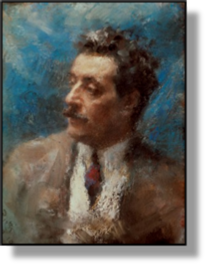 xxxxxThe Italian Giacomo Puccini, born into a family with a
long history of music, was one of the greatest opera composers of
all time. His works, noted for their free-
xxxxxThe Italian Giacomo Puccini, born into a family with a
long history of music, was one of the greatest opera composers of
all time. His works, noted for their free-
xxxxxBorn in Lucca, Tuscany, Puccini was the last in a long line of family musicians who served as choirmasters and organists at the city’s Cathedral of San Martino. As a child, in fact, he showed no special aptitude in music, but the family were determined that he follow in the footsteps of his forebears. His father died in 1863, when Puccini was five years old, but the family was assisted financially by a small pension from the city council. The young Puccini was taught music by his maternal uncle Fortunato Magi, and then attended the Musical Institute at Lucca. He was playing the organ at San Martino by the age of fourteen, and, five years later, as family tradition would have it, was acting as choirmaster and organist, and beginning to produce his own compositions. In the meantime, however, his interest had been aroused in another direction. In 1876 he had trekked thirteen miles to the city of Pisa to attend a performance of Giuseppe Verdi’s opera Aida. It proved a turning point in his life. He was inspired by the music and the grandeur of the production, and became firmly convinced that his future lay as an opera composer.
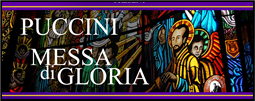 xxxxxHis Messa di Gloria,
composed in 1880 and providing early indication of his powers of
dramatic orchestration, marked the end of his family’s long
association with church music in Lucca. In that year, with financial
aid from family members and a scholarship from Queen Margherita of
Italy, he was able to attend the musical conservatory at Milan. Hexspent
the next three years studying composition, and it was during that
time that he was encouraged in his chosen career by one of the
teachers, the Italian opera composer Amilcare
Ponchielli (1834-
xxxxxHis Messa di Gloria,
composed in 1880 and providing early indication of his powers of
dramatic orchestration, marked the end of his family’s long
association with church music in Lucca. In that year, with financial
aid from family members and a scholarship from Queen Margherita of
Italy, he was able to attend the musical conservatory at Milan. Hexspent
the next three years studying composition, and it was during that
time that he was encouraged in his chosen career by one of the
teachers, the Italian opera composer Amilcare
Ponchielli (1834-
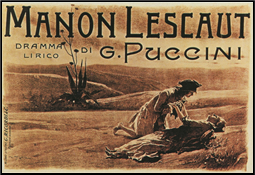 xxxxxOn the strength of this success, Ricordi provided him
with a monthly stipend and commissioned a second opera. Puccini at
once set to work, and his lyrical drama Edgar
was staged at La Scala, Milan, in 1889. It was, in fact, a dismal
failure, due in large part to a weak story and a poor libretto, but
Ricardo continued to support his young protégé, instructing him to
“find a good subject and a good librettist”. Puccini was close to
despair, but he took his advice. After a lengthy search, his next
major work, Manon Lescaut, was written by
two talented librettists, Luigi Illica and Giuseppe Giacosa, and
their work did justice to the musical score and the subject matter.
Premiered at Turin in 1893, the opera was a huge success, and within
a few years was being performed as far afield as St. Petersburg, Rio
de Janeiro and Philadelphia. It brought Puccini international fame,
and in Italy he was seen as a worthy successor to Verdi -
xxxxxOn the strength of this success, Ricordi provided him
with a monthly stipend and commissioned a second opera. Puccini at
once set to work, and his lyrical drama Edgar
was staged at La Scala, Milan, in 1889. It was, in fact, a dismal
failure, due in large part to a weak story and a poor libretto, but
Ricardo continued to support his young protégé, instructing him to
“find a good subject and a good librettist”. Puccini was close to
despair, but he took his advice. After a lengthy search, his next
major work, Manon Lescaut, was written by
two talented librettists, Luigi Illica and Giuseppe Giacosa, and
their work did justice to the musical score and the subject matter.
Premiered at Turin in 1893, the opera was a huge success, and within
a few years was being performed as far afield as St. Petersburg, Rio
de Janeiro and Philadelphia. It brought Puccini international fame,
and in Italy he was seen as a worthy successor to Verdi -

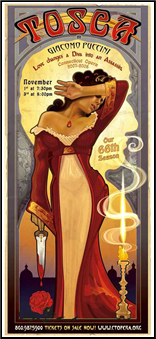
xxxxxManon
Lescaut was followed by one of his most
successful and enduring works, La Bohème.
Staged in the same city in 1896, it
received a cool reception on its first night, but soon came to be
regarded as one of the most romantic operas ever composed,
remembered above all for its wealth of lyrical moments. And
Puccini’s fame and fortune was
further extended four years later with his dramatic Tosca,
a work noted for its verismo (down to
earth style), and acclaimed for the natural beauty of its melody and
its tense drama of passion, revenge and treachery, so brilliantly
captured by its orchestration. It quickly took its place on the
repertoire of all the major opera houses. Andxit was in 1900, while in London, that Puccini saw and
was greatly impressed by the play Madame
Butterfly, the work of the American producer and
impresario David Belasco
(1853-
xxxxxBy
then, Puccini was enjoying the fruits of his labour. In 1900 he
built a villa at Torre del Lago, close to Lucca, a small fishing
village on Lake Massaciuccoli where he had lived with his mistress,
a married woman named Elvira Bonturi, since 1891. There he led the
life of a country gentleman, hunting, fishing, and spending a
fortune on a collection of cars and motor boats. He said himself
that he was the “mighty hunter of wild fowl, operatic librettos and
attractive women” -
xxxxxBut
the early years of the 20th century were not without their sadness
and distress. He was badly injured in a car crash in 1903 (having to
spend 8 months in a wheel chair), his librettist Giacosa died three
years later, and Ricordi, his friend and father-
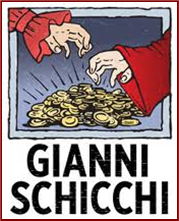
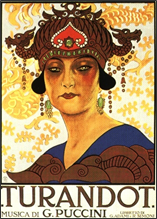 xxxxxPuccini’s
later works included The Girl of the Golden West
(another play by Belasco) -
xxxxxPuccini’s
later works included The Girl of the Golden West
(another play by Belasco) -
xxxxxDuring
his final years, while working on Turando,
Puccini suffered from depression, brought on by doubts about his
ability and his marked decline in health. He died in Brussels of a
heart attack, five days after undergoing an operation for throat
cancer. He was buried in Milan, but his remains were later taken for
burial at Torre del Lago -
 xxxxxPuccini was a master of the theatre and therein lay his
greatness. He had an uncanny feeling for the stage, and brought to
it high points of emotional drama balanced by unforgettable moments
of contemplation and tenderness. His tragic love stories, woven
around the likes of the innocent Mimi, the abandoned Butterfly or
the troubled Tosca, were notable for their beautiful and haunting
melodies, and their exotic settings added to their appeal. His
operas might well be seen as rather too dramatic, passionate and
sentimental, but they aroused emotions that touched the hearts of
his audience and brought him international success. This he achieved
by retaining the traditional vocal style associated with Verdi but,
at the same time, fusing music and drama together in the mode of
Richard Wagner. As a master of orchestration, he made every note,
every chord, every instrument play a part in supporting and shaping
the story unfolding on stage. The result was theatre magic. And
contributing to this magic was a string of arias, be it Your
tiny hand is frozen from La Bohème,
One Fine Day from Madame
Butterfly, or
None shall sleep from Turandot,
that are known and loved the world over.
xxxxxPuccini was a master of the theatre and therein lay his
greatness. He had an uncanny feeling for the stage, and brought to
it high points of emotional drama balanced by unforgettable moments
of contemplation and tenderness. His tragic love stories, woven
around the likes of the innocent Mimi, the abandoned Butterfly or
the troubled Tosca, were notable for their beautiful and haunting
melodies, and their exotic settings added to their appeal. His
operas might well be seen as rather too dramatic, passionate and
sentimental, but they aroused emotions that touched the hearts of
his audience and brought him international success. This he achieved
by retaining the traditional vocal style associated with Verdi but,
at the same time, fusing music and drama together in the mode of
Richard Wagner. As a master of orchestration, he made every note,
every chord, every instrument play a part in supporting and shaping
the story unfolding on stage. The result was theatre magic. And
contributing to this magic was a string of arias, be it Your
tiny hand is frozen from La Bohème,
One Fine Day from Madame
Butterfly, or
None shall sleep from Turandot,
that are known and loved the world over.
xxxxxIncidentally, Puccini was born Giacomo Antonio Domenico Michele
Seconda Maria Puccini! The earlier members of his family were
Giacomo Puccini (1712-
xxxxx…… Edgarxwas based on a verse drama by the French writer Alfred
de Musset. Manon Lescaut, was based on
the celebrated novel by the French writer Abbé Prévost, and, with
the title Manon, had been produced as an
opera by the French composer Jules Massenet in 1884. La
Bohème was
based on Scènes de la vie de bohème by
the French novelist Henri Murger (1822-
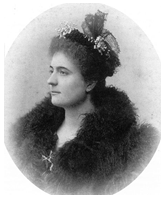
xxxxx…… Asxnoted
above, Puccini’s life was not without its own drama. His life with
Elvira Bonturi
(1860-
xxxxx…… It was during Puccini’s rise to fame, between the production of his The Wills and Manon Lescaut, that Italy’s other great opera composer, Giuseppe Verdi, staged his last two works, Otello in 1887 and Falstaff in 1893. He and Puccini were never close friends.
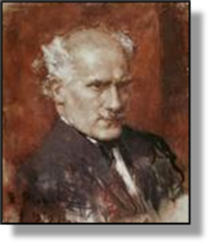 xxxxxThe Italian musician Arturo
Toscanini (1867-
xxxxxThe Italian musician Arturo
Toscanini (1867- were
not on the best of terms, sent his conductor a panettone,
a sweet bread loaf, as a Christmas gift. Realising his mistake, he
then sent a wire with the message “Panettone
sent by mistake, Puccini”. Back came the reply: “Panettone
eaten by mistake, Toscanini”!
were
not on the best of terms, sent his conductor a panettone,
a sweet bread loaf, as a Christmas gift. Realising his mistake, he
then sent a wire with the message “Panettone
sent by mistake, Puccini”. Back came the reply: “Panettone
eaten by mistake, Toscanini”!
xxxxxPuccini’s
one-
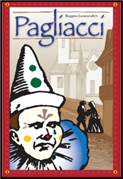 xxxxxThe tragedy Pagliacci (The Strolling Players) was the work of the
Italian composer Ruggero Leoncavallo (1858-
xxxxxThe tragedy Pagliacci (The Strolling Players) was the work of the
Italian composer Ruggero Leoncavallo (1858-
Vc-
Including:
Arturo Toscanini,
Pietro Mascagni and
Ruggero Leoncavello



